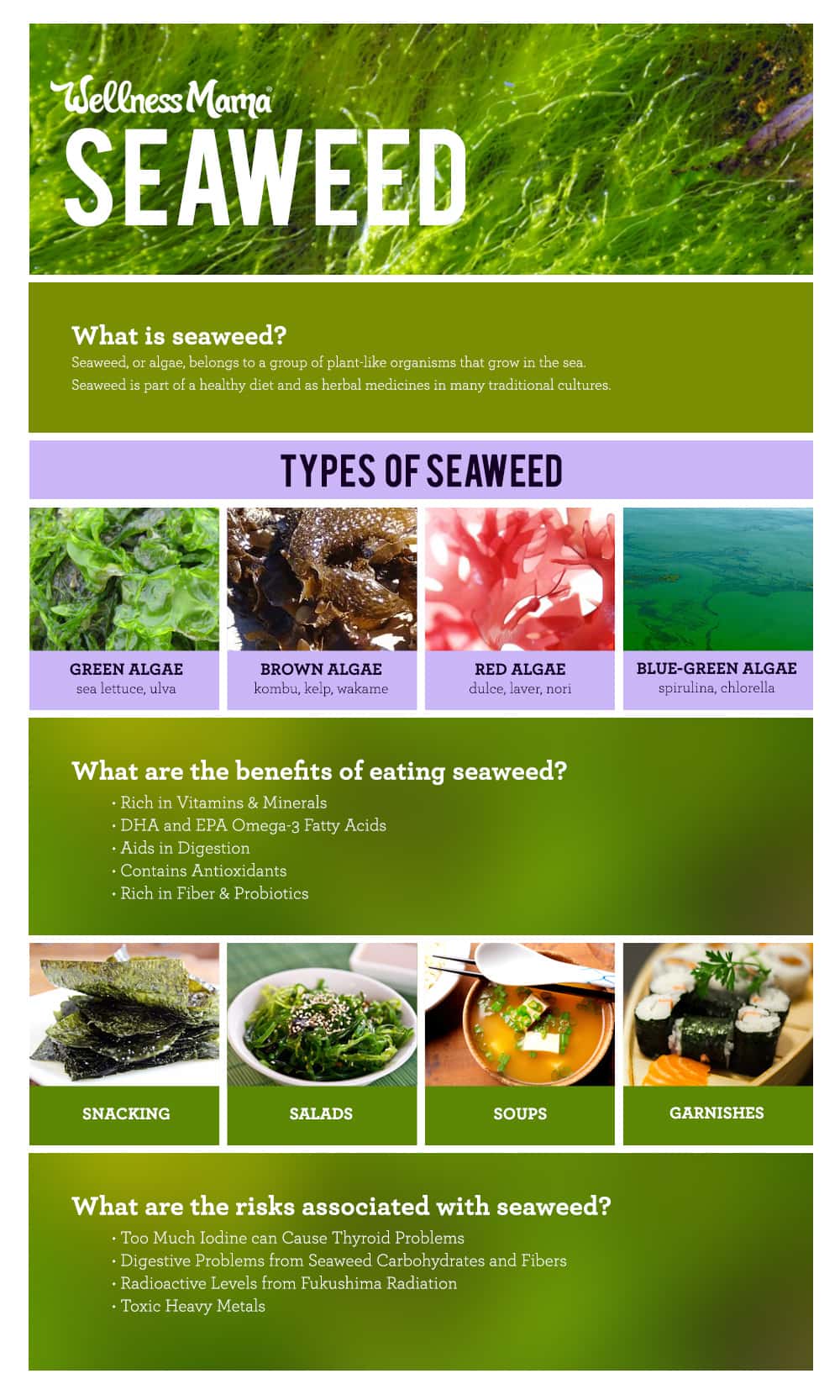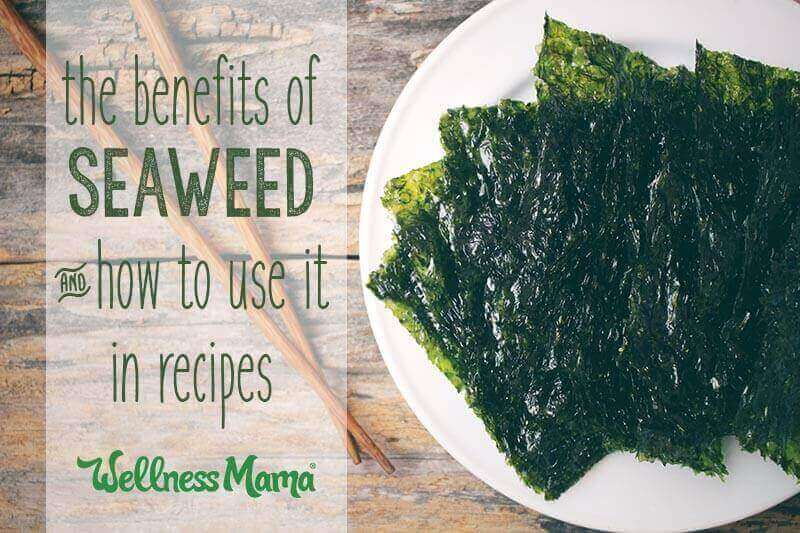Most of us are familiar with seaweed in our sushi, and the accompanying miso soup. But beyond the delicious taste, have you ever wondered about the health benefits of seaweed?
Incredibly rich in antioxidants, vitamins, and minerals, seaweed packs a serious nutritional punch.
What Is Seaweed?
Seaweed, or algae, belongs to a group of plant-like organisms that grow in the sea.
Some algae are one-celled organisms such as microalgae, which means that they are more like bacteria that also generate energy through photosynthesis.
Most of the seaweed that we consume as food have many cells. Seaweed is part of a healthy diet and is used in herbal medicines in many traditional cultures.
What Are the Different Types of Seaweed?
Scientists have categorized types of seaweed into different categories based on their pigments, cell structure, and other traits. The groups (or phyta) of seaweed that are commonly consumed include:
- Green algae such as sea lettuce or ulva, and sea grapes
- Brown algae such as kombu, arame, kelp, and wakame (the miso soup seaweed)
- Red algae such as dulse, laver, and nori (the sushi seaweed)
- Blue-green algae such as spirulina and chlorella
How to Cook and Eat Seaweed
If you live near an Asian market or Chinatown, you may be able to find fresh seaweed. Otherwise, you may find many types of dried seaweeds in the supermarket and online, such as on Amazon.
Dried seaweed would need to be soaked in hot water, and rinsed well before use. Some thicker and tougher seaweed like kombu might be better sliced thin or boiled.
Seaweeds are very versatile. Here are a few different ways to enjoy them:
- Snacking out of a bag – Nori and dulse can just be eaten out of a bag. You will want to check the labels and watch out for some brands of snacking nori that contain a lot of MSG though. Seasnax is a good brand for this that uses seaweed from Korea and clean ingredients.
- Salads – Most types of seaweed can be made into a Japanese-style salad with vinegar, sesame oil, ginger, and garlic. Try this recipe.
- Soups – Seaweed tastes delicious in bone broth, which makes it seaweed soup.
- Sprinkled on other foods – Seaweed flakes can be sprinkled on salads, rice, soups, or any other dishes.
Most seaweed is not bitter. Some types are a bit sweet and may even have umami flavors, which means that it may be easier to get some picky eaters to eat seaweed than vegetables.
Benefits of Seaweed
The unique properties of seaweed make it beneficial to the body in several ways. Here are a few seaweed benefits:
Vitamins and Minerals
Seaweed is much more nutrient dense than any land vegetables. It is an excellent source of micronutrients including folate, calcium, magnesium, zinc, iron, and selenium. More importantly, seaweed is a great source of iodine.
DHA and EPA omega-3 fatty acids
Unlike land plants, seaweed contains preformed omega-3 fatty acids DHA and EPA, so seaweed or algae oil can be a reliable source of omega-3 for vegetarians.
Aids with Digestion
Beans can cause gas and stomach upset for many people. This can be easily fixed by adding kombu, a particular kind of seaweed, to the beans when cooking.
Antioxidants
Seaweed contains many antioxidants. As part of a healthy diet, seaweed can help protect against oxidative stresses and prevent chronic diseases such as cancer and digestive problems.
Fiber and Prebiotics
All plants contain fiber, but seaweed also has other odd types of carbohydrates that we lack the digestive enzymes to digest. These include carrageenan, fucan, galactan, and many more. These carbohydrates then become foods for the bacteria (see this study for a more detailed explanation).
What you eat directly influences which bacteria dominates in your gut. The types of bacteria that can feed best on the foods you choose to eat will grow better (read more on this fascinating topic here). This explains why some cultures handle different types of food better than others. In fact, scientists found that the gut bacteria in healthy Japanese people are higher in bacteria that can digest the types of carbohydrates in seaweed (source).
Potential Risks from Eating Seaweed
There are a couple potential concerns to be aware of when consuming seaweed:
Too Much Iodine Can Cause Thyroid Problems
Iodine is a very important mineral for thyroid functions, and seaweed is a great source of iodine. While the thyroid can adjust to higher intakes of iodine, it is possible to develop thyroid problems from too much iodine. This may be especially true if you are susceptible to thyroid issues (like me).
A Japanese study found that women who regularly consumed 15 – 30 grams of kombu had elevated TSH, and reduced free T3 and T4. When these women stopped consuming seaweed, then their TSH and thyroid hormone levels returned to normal. Therefore, the authors of this study recommended not to exceed 3 mg of iodine (a serving of seaweed typically contains 20 – 50 mg).
Asian cuisines typically serve seaweed along with foods that contain goitrogens that inhibit iodine absorption by the thyroid. These include the common Asian staples such as tofu, soy milk, and cruciferous vegetables. This might explain why most Japanese and other Asian people can consume seaweed without any problem (source).
Those with existing thyroid disease (or those predisposed to it) should monitor total iodine intake. This is especially important for those who live in countries that fortify foods and table salts with iodine. Generally, consumption of seaweed on occasion (2 – 3 times a week) as a condiment (1 – 2 tablespoons) generally will not exceed the 3 mg limit of iodine.
To be safe, monitor thyroid hormone levels with your doctor as you introduce seaweed into your diet to see if eating seaweed will possibly cause a thyroid problem for you.
Digestive Problems from Seaweed Carbohydrates and Fibers
Seaweed contains many types of carbohydrates our digestive system can’t digest. These carbohydrates are passed down to our gut bacteria. For people prone to digestive problems or with small intestinal bacterial overgrowth, these carbohydrates cause significant issues.
The food industry widely uses these carbohydrates, such as carrageenan and agar, to stabilize or texturize foods in the food industry. Carrageenan, in particular, is very problematic. It causes inflammation both in the gut and throughout the human body. It is therefore very wise to avoid carrageenan as a food additive.
While pure carrageenan has been linked to health problems, there is no study linking carrageenan in whole food sources to the same problems that have been linked to carrageenan in isolation. It is perhaps best to avoid seaweeds that are higher in carrageenan content such as Irish moss and occasionally enjoy other seaweeds in moderation.
Radioactive Levels from Fukushima Radiation
A high iodine diet can protect against radioactivity. This is why when the Fukushima nuclear plant melted down, the Japanese government gave iodine supplements to aid workers and evacuees.
Chris Kresser discusses the topic of Fukushima radiation in Pacific seafood in this blog post. He states that the levels of radiation in the US Pacific coast are rather insignificant when compared to other background sources of radiation that already exist in the US, or compared to our exposure flying on an airplane. Bottom-feeding fish near the coasts of Japan show more contamination, but even then the levels of radioactivity fall below the international dose limit.
In fact, Maine Coast, a seaweed purveyor that regularly tests their products for toxins, found that their products only have background levels of radioactivity even right after the Fukushima event in March 2011 (source).
Because seaweed is at the bottom of the food chain (where it is eaten by other animals), the concentration of toxins in seaweed is much less than in fish or other animals that eat the seaweed.
Toxic Heavy Metals
While rich in beneficial minerals, seaweed also can contain toxic metals. This likely depends on the type of the seaweed, where it is harvested from, and the variation of toxin levels in the water. Several reports detail the heavy metal content of seaweed:
- Heavy metals in laver, seatangle, sea mustard, hijiki, and gulfweed from the South Korea coast are below safety limits (source, and source).
- Hijiki, regardless of brand, contains arsenic that is above the safety limit (source).
- A Spanish study extensively compared various types of seaweed imported from Japan, China, Korea, and Chile that are sold in Spain. They concluded that most seaweed products are safe with respect to WHO guidelines. However, some species such as Hijiki and H. fusiforme may be high in arsenic (source).
Heavy metals levels in seaweed can really vary from batch to batch. The best way to know for sure is to purchase your seaweed from companies that regularly third-party lab test their products for heavy metal levels. One company I like that does this is Maine Coast. They publish their test results on their website here.
Remember that heavy metal exposure also comes through other sources like the environment and foods like fish and seafood. Everyone’s ability to remove these heavy metals from their bodies differs. If you are concerned about heavy metal levels, it might be wise to avoid seaweed and seafood altogether.
Seaweed as a Superfood: How It Stacks Up
- There are many benefits of seaweed and it is a very nutritious food.
- Healthy people can enjoy seaweed as a condiment a few times a week.
- If you have concerns about thyroid health or digestive function, you may want to speak to your doctor about monitoring your condition as you introduce more seaweed into your diet.
- With a few exceptions, radioactivity and heavy metal toxicity is of low concern for seaweed.
- In general, seaweed harvested from the Korean coast is quite safe.
When in doubt, purchase your seaweed from a reputable company that tests their products for contamination, such as Maine Coast.
What is your experience with seaweed? Do you have any concerns about its safety? Please share in the comments below.


Leave a Reply